
Ancyloceras is an extinct genus of heteromorph ammonites found throughout the world during the Lower Cretaceous, from the Lower Barremian epoch until the genus extinction during the Lower Aptian.
Balearites is an extinct ancyloceratin genus included in the family Crioceratitidae, subclass Ammonoidea, from the Upper Hauterivian.
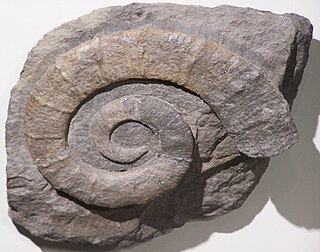
Crioceratites is an ammonite genus from the Early Cretaceous belonging to the Ancyloceratoidea.
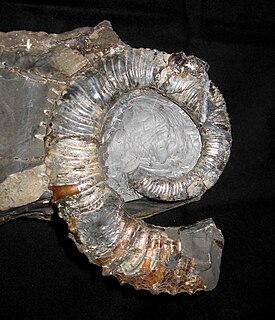
Exiteloceras is an ammonite genus from the Late Cretaceous.
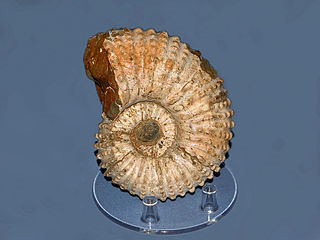
Douvilleiceras is a genus of ammonites from the Middle to Late Cretaceous. Its fossils have been found worldwide, in Africa, Asia, Europe, and North and South America.
Ogmodirus is an extinct genus of plesiosaur found in the Cenomanian-Turonian Greenhorn Limestone of Kansas. It may be member of the Elasmosauridae, a group of marine animals related to Elasmosaurus, but the condition of the fossils discovered to date means the genus is dubious beyond Plesiosauria. The type species, O. martini, was named by Samuel Wendell Williston and Roy L. Moodie in 1913. The original specimen consisted of a pelvic girdle, limb elements, and more than fifty cervical (neck) vertebrae discovered in Cloud County, Kansas. A second species, Ogmodirus ischiadicus, has since been referred to Styxosaurus. Sepkoski (2002) assigned Ogmodirus to the Plesiosauria.
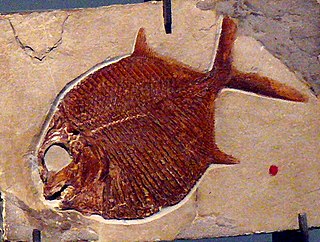
Pycnodontiformes is an extinct order of bony fish. The group evolved during the Late Triassic and disappeared during the Eocene. The group has been found in rock formations in Africa, Asia, Europe, North and South America.

Mammites is a Late Cretaceous ammonite genus included in the acanthoceratoidean family, Acanthoceratidae, and the type genus for the subfamily Mammitinae. Mammites was named by Laube and Bruder in 1887.
The Amphidontidae are a family of extinct mammals from the Early Cretaceous, belonging to the triconodonts. It contains most of the species previously belonged to Amphilestidae.

Pachydesmoceras is a genus of ammonites belonging to the family Desmoceratidae.

Calycoceras is an extinct genus of cephalopods belonging to the subclass Ammonoidea and family Acanthoceratidae that lived during the Cenomanian stage of the Late Cretaceous, 100-94 Mya. Their shells had ornate ribs.
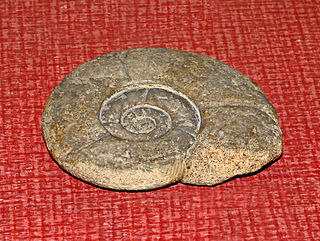
Puzosia is a genus of desmoceratid ammonites, and the type genus for the Puzosiinae, which lived during the middle part of the Cretaceous, from early Aptian to Maastrichtian. Sepkoski defines the range from Albian to Santonian. The generic name comes from the Serbian words "Puž" (snail) and "oce/ose" (axis), gaining its name from the shell's snail-like appearance.

Pterorigonia is an extinct genus of saltwater clams, marine bivalve molluscs in the family Megatrigoniidae. This genus is known in the fossil record from the Jurassic period Tithonian age to the Cretaceous period Maastrichtian age. Species in this genus were facultatively mobile infaunal suspension feeders. The type species of the genus is Pterotrigonia cristata.

Phyllopachyceras is an extinct genus of ammonoid cephalopods belonging to the family Phylloceratidae. These nektonic carnivores lived in the Cretaceous, from Hauterivian to Maastrichtian to age.

Dufrenoyia is an extinct genus of Cretaceous ammonites included in the family Parahoplitidae. These fast-moving nektonic carnivores lived in the Cretaceous period. The type species of the genus is Ammonites dufrenoyi.

The Forbes Shale is a geologic formation in the Sacramento Valley of northern California, United States. It is found in the Sutter Buttes area of Sutter County, California. It preserves fossils dating back to the Coniacian stage of the Late Cretaceous period.

Ostlingoceras is an extinct genus of ammonites belonging to the Turrilitidae family.

Purpuroidea is an extinct genus of sea snails, marine gastropod molluscs in the clade Littorinimorpha.

Pygurus is a genus of sea urchins belonging to the family Clypeidae.
The following is a taxonomy of the Brachiopoda by Emig, Bitner & Álvarez (2019). There are over 400 living species and over 120 living genera of brachiopods classified within 3 classes and 5 orders, listed below.
















